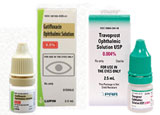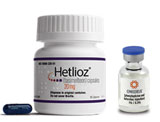  |
Large pharmaceutical companies used to introduce new drugs to the market with a great deal of fanfare. Remember the days of listening to podium talks, reading sponsored supplements or participating in webinars where landmark drugs such as Restasis (cyclosporine, Allergan) Travatan (travoprost, Alcon) or Zylet (loteprednol/tobramycin, Bausch + Lomb) were first launched? Check the back of your desk drawer—you may still have a pen or notepad bearing these logos. Well, that’s all changed now. Industry has diminished its promotional outreach in an effort to adhere to Pharmaceutical Research and Manufacturers of America (PhRMA) guidelines.
Indeed, those days of passive learning are behind us. The result of this diminished exposure is reduced physician awareness of new products. We’re here to make sure you’re not left in the dark. In this month’s column, we hope to shine a spotlight on some recent introductions to the ophthalmic “medicine cabinet.”
Allergy
It’s likely you’ve at least heard of Pazeo (olopatadine 0.7%, Alcon Laboratories), which received FDA approval in January. At 0.7%, Pazeo contains seven times the olopatadine concentration in the company’s original olopatadine formulation, Patanol, and 3.5 times the concentration in Pataday. Pazeo is approved for the relief of ocular itching associated with allergic conjunctivitis, with a recommended dosing of once daily. Although Pataday also enjoys once daily dosing, Pazeo demonstrated slightly greater relief of itching at 24 hours post-treatment in a head-to-head comparison with Pataday.1
While Pazeo banners were visible at the SECO International meeting in March, little information has trickled down to practitioners. Samples have yet to be received at either of our academic institutions.
Allergen-specific immunotherapy has traditionally been employed in younger patients whose symptoms are not adequately controlled with pharmacotherapy, or who cannot tolerate anti-allergy medications.2,3 In years past, this consisted of “allergy shots”—subcutaneous injections of the actual allergen, given in an effort to progressively desensitize the patient’s immune system.4 The recently developed sublingual immunotherapy (SLIT) technology incorporates an allergen extract in dissolvable tablet form placed under the tongue for a defined amount of time and then swallowed. Three such products received FDA approval in 2014. These include Oralair (sweet vernal, orchard, perennial rye, timothy and Kentucky blue grass mixed pollens allergen extract, Greer Labs), Grastek (timothy grass pollen allergen extract, Merck) and Ragwitek (short ragweed pollen allergen extract, Merck).5-7
 | |
| Several new pharmaceutical options are now available to help patients, like this little guy, with allergic rhinoconjunctivitis. |
All of these products are indicated “as immunotherapy for the treatment of…pollen-induced allergic rhinitis, with or without conjunctivitis.” Hence, these agents may have implications for many of our patients.
The FDA further requires that all individuals receiving SLIT for allergy management must have laboratory confirmation by either a positive skin test or in vitro testing for pollen-specific IgE antibodies.5 We support recommendations that such testing and initiation of therapy be performed only by physicians certified in the treatment of allergy by the American Board of Allergy and Immunology (ABAI).
Glaucoma
A recent study published in the American Journal of Ophthalmology concluded that Izba (travoprost 0.003%, Alcon), a glaucoma medication approved last year, provided equivalent IOP-lowering efficacy to benzalkonium chloride-preserved travoprost 0.004% in patients with open-angle glaucoma and ocular hypertension.8 Although Izba is currently listed on the FDA’s website of approved drug products (www.accessdata.fda.gov/scripts/cder/drugsatfda/), we are not aware of any marketing efforts in the United States to date, and the product is not currently available for purchase in pharmacies. A generic version of travoprost 0.004% (Par Pharmaceutical) received FDA approval in 2013, and just recently came to market.
 | |
| Generic gatifloxacin and travoprost are now available in the United States. |
Other Generics
While we’re on the subject of generics, three generic versions of bimatoprost 0.03% will soon hit the market from manufacturers Lupin Pharmaceuticals, Apotex and Alcon, the last of whom, in addition to making numerous branded pharmaceuticals, has a thriving business in generics (Falcon). While generic bimatoprost is not yet available in the United States, we anticipate seeing pharmacies carry this product within the next year or two.
A generic version of Zymaxid (0.5% gatifloxacin, Allergan) also recently hit US pharmacies. Both Lupin Pharmaceuticals and Hi-Tech Pharmacal have gained FDA approval to manufacture 0.5% gatifloxacin solution, although the latter company’s product is being marketed through Akorn. The price of generic gatifloxacin appears to be substantially less than branded Zymaxid and, to our knowledge, this is the first topical fourth-generation fluoroquinolone to attain generic status.
Other Ophthalmic Agents
Two additional drugs with ophthalmic indications received FDA approval in 2014, although it is unlikely optometrists will directly use either. Omidria (intracameral phenylephrine 1%/ketorolac 0.3%, Omeros) is an intraocular injection indicated for maintenance of pupil size by preventing intraoperative miosis, as well as the reduction of postoperative pain associated with cataract surgery or intraocular lens replacement.9
 | |
| Two new drugs with implications in eye care: Hetlioz is indicated for management of non-24, while Omidria is used to maintain pupillary dilation during intraocular surgery. |
Adequate dilation is crucial to a positive outcome in the aforementioned procedures, and numerous factors can contribute to poor or ill-sustained pharmacologic mydriasis; these can include long-term use of topical miotic agents (e.g. pilocarpine), diabetes, pseudoexfoliation syndrome, prior trauma or uveitis, and intraoperative floppy iris syndrome associated with chronic use of oral alpha-adrenergic antagonists such as Flomax (tamsulosin, Boehringer Ingelheim).10 Omidria is added preoperatively to the surgical irrigating solution and is infused into the eye throughout the procedure. This way, rather than diluting the preoperative mydriatics, a relatively constant concentration of phenylephrine and ketorolac is delivered to the anterior chamber. The efficacy and safety of Omidria has been well demonstrated in a large, multicenter international clinical trial.11
Finally, Hetlioz (tasimelteon 20mg capsules, Vanda Pharmaceuticals) is indicated for an unusual condition known among sufferers as “non-24.” Non-24-hour sleep-wake disorder is a serious, chronic malady that disrupts an individual’s circadian rhythms due to an inability to differentiate day from night. Although it may rarely affect sighted or partially-sighted individuals, non-24 is most common in those with no light perception, affecting between 55% and 70% of totally blind patients.12 Researchers believe it results from a dysregulation of endogenous melatonin secretion in the brain, with resultant somnolence during daytime hours as well as insomnia at night. Hetlioz is a melatonin-receptor agonist, helping to both stimulate the sleep centers in the brain while restoring a more synchronous, regular circadian rhythm.13 Although Hetlioz is not the first melatonin-receptor agonist to be approved by the FDA, it is the first drug to be specifically indicated for the treatment of non-24.13
While this agent is not classified by the FDA as a scheduled drug, only a sleep specialist is qualified to confirm a diagnosis of non-24, and therefore the prescription use of Hetlioz is most appropriately limited to these physicians.
Dr. Kabat is clinical care consultant at TearWell Advanced Dry Eye Treatment Center in Memphis, Tenn. Neither he nor Dr. Sowka have any direct financial interest in the products mentioned above.
1. PAZEO [package insert]. Ft. Worth, TX: Alcon Laboratories, Inc.; 2015.2. Lierl MB. Allergen immunotherapy: shots for asthma, wheezing, and bee sting. Pediatr Ann. 2011 Apr;40(4):192-9.
3. Joint Task Force on Practice Parameters; American Academy of Allergy, Asthma and Immunology; American College of Allergy, Asthma and Immunology; Joint Council of Allergy, Asthma and Immunology. Allergen immunotherapy: a practice parameter second update. J Allergy Clin Immunol. 2007 Sep;120(3 Suppl):S25-85.
4. La Rosa M, Lionetti E, Reibaldi M, et al. Allergic conjunctivitis: a comprehensive review of the literature. Ital J Pediatr. 2013 Mar 14;39:18.
5. ORALAIR [package insert]. Lenoir, NC: Greer Laboratories, Inc.; 2014.
6. GRASTEK [package insert]. Whitehouse Station, NJ: Merck Sharp & Dohme Corp., a subsidiary of Merck & Co., Inc.; 2014.
7. RAGWITEK [package insert]. Whitehouse Station, NJ: Merck Sharp & Dohme Corp., a subsidiary of Merck & Co., Inc.; 2014.
8. Peace JH, Ahlberg P, Wagner M, et al. Polyquaternium-1-preserved travoprost 0.003% or benzalkonium chloride-preserved travoprost 0.004% for glaucoma and ocular hypertension. Am J Ophthalmol. 2015 Apr 29. [Epub ahead of print]
9. OMIDRIA [package insert]. Seattle, WA: Omeros Corporation; 2013.
10. Espandar L, Kim T. Pharmacologic approaches to the small pupil. Cataract & Refractive Surgery Today. 2014 Feb;15(2):31-4.
11. Lindstrom RL, Loden JC, Walters TR, et al. Intracameral phenylephrine and ketorolac injection (OMS302) for maintenance of intraoperative pupil diameter and reduction of postoperative pain in intraocular lens replacement with phacoemulsification. Clin Ophthalmol. 2014 Sep 5;8:1735-44.
12. Roth T, Nir T, Zisapel N. Prolonged release melatonin for improving sleep in totally blind subjects: a pilot placebo-controlled multicenter trial. Nat Sci Sleep. 2015 Jan 29;7:13-23.
13. Bonacci JM, Venci JV, Gandhi MA. Tasimelteon (Hetlioz): A New Melatonin Receptor Agonist for the Treatment of Non-24-Hour Sleep-Wake Disorder. J Pharm Pract. 2014 Aug 3. [Epub ahead of print].

